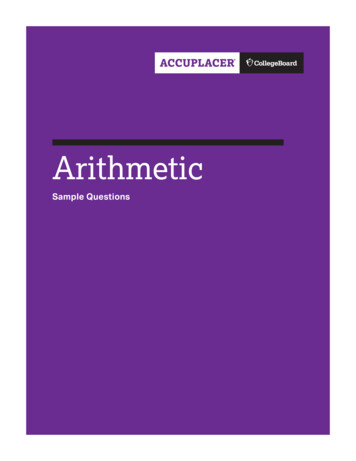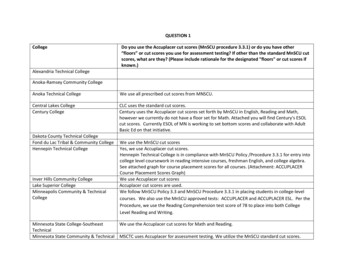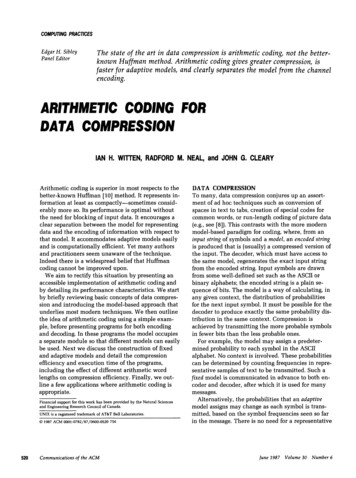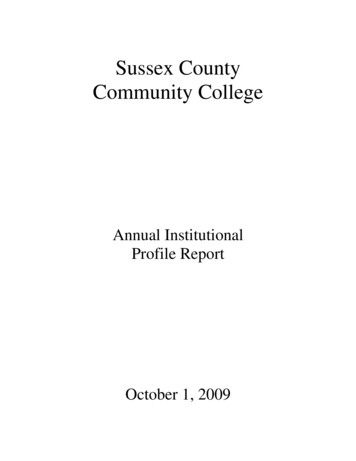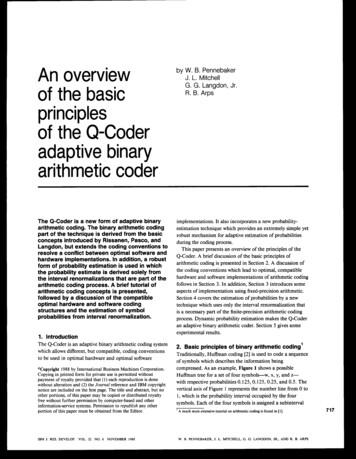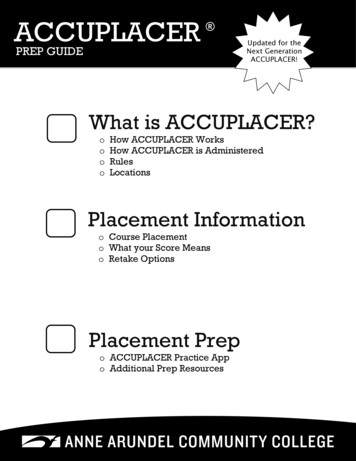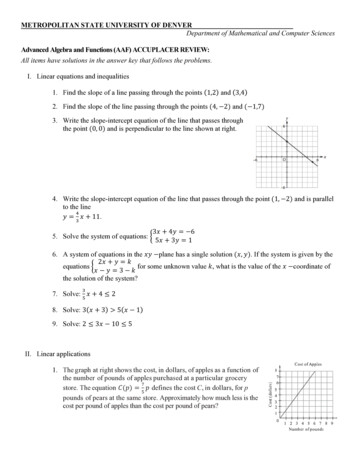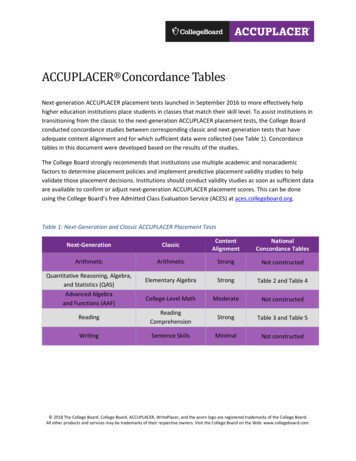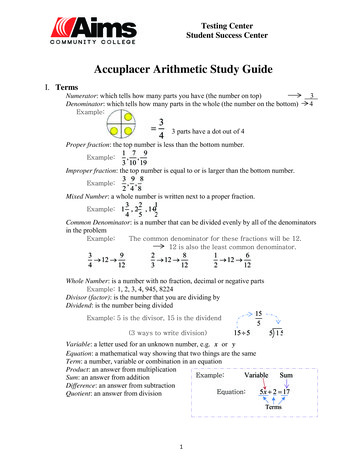
Transcription
Testing CenterStudent Success CenterAccuplacer Arithmetic Study GuideI. TermsNumerator: which tells how many parts you have (the number on top)Denominator: which tells how many parts in the whole (the number on the bottom)34Example: 343 parts have a dot out of 4Proper fraction: the top number is less than the bottom number.1 7 9Example:, ,3 10 19Improper fraction: the top number is equal to or is larger than the bottom number.3 9 8Example:, ,2 4 8Mixed Number: a whole number is written next to a proper fraction.3 21Example: 1 , 2 , 1 04 52Common Denominator: is a number that can be divided evenly by all of the denominatorsin the problemExample:39 12 412The common denominator for these fractions will be 12.12 is also the least common denominator.28 12 31216 12 212Whole Number: is a number with no fraction, decimal or negative partsExample: 1, 2, 3, 4, 945, 8224Divisor (factor): is the number that you are dividing byDividend: is the number being divided15Example: 5 is the divisor, 15 is the dividend515 5(3 ways to write division)5 15Variable: a letter used for an unknown number, e.g. x or yEquation: a mathematical way showing that two things are the sameTerm: a number, variable or combination in an equationProduct: an answer from multiplicationExample:VariableSumSum: an answer from additionDifference: an answer from subtraction5x 2 17Equation:Quotient: an answer from divisionTerms1
II. FractionsA. Reducing Fractions to Lowest TermsStep 1: Find a number that goes evenly into the numerator and the denominator of thefraction.Example:The number that will go in evenly is 848 8 6 64 8 8Step 2: Check to see whether another number goes evenly into both the numerator anddenominator. Stop when there are no more numbers that can go into the fraction.Example:The fraction can be reduced further by dividing it by 26 2 3 8 2 4B. Changing Mixed Numbers to Improper FractionsStep 1: Multiply the denominator by the whole number.3Example: Change 2to an improper fraction42 4 8Step 2: Add the result to the numerator8 3 11Step 3: Place the total over the denominator.114C. Adding and Subtracting Fractions with Different Denominators (Bottom Numbers)Example 1:3 2 4 33 3 9 4 3 122 48 3 4 129 8 175 1 *12 12 12 12Step 1: Need to find the commondenominator for all fractionsStep 2: Then go ahead and add orsubtract the fractions.Example 2:3 4 12 4 4 163 1 3 16 1 1612 39 16 16 16*Remember to change improper fractions to a mixed number.D. Multiplying FractionsStep 1: Multiply the numerators across.Step 2: Then multiply the denominators across.Make sure the product is in lowest terms23 3 4 163 5 15 4 6 2415 3 5 24 3 8
E. Multiplying Fractions with Mixed Numbers2 22 1 3 5Step 1: Change every mixed fraction to an improper fraction.22 8 3 32 71 5 58 7 56 3 5 15Step 2: Then multiply acrossStep 3: Then change the improper fraction to a mixed number in lowest terms.5611 31515F. Dividing FractionsThe fraction that is right of the division sign will need to be turned upside down bywriting the numerator in the denominator and the denominator in the numerator. Thenfollow the rules for multiplying fractions.1 1Example: 4 21 2 22 2 1Simplify 4 1 44 2 2Practice:1) Change 43)535 2231to an improper fraction. 2) Change61115924)5) 136)21 3 2321 57) 3 7 99)42to a mixed number.1671083 27378) 3 2 796 14 114510) 3 5 56III. DecimalsA. Adding and Subtracting DecimalsExample – Add: 28.5 44.47 307.628.5044.47 3075.603148.57Example – Subtract: 380.53 75Step 1: Line up the decimal points.Step 2: Then add or subtract3380.53 75.00305.53
B. Multiplying DecimalsExample: Multiply 1.89 5.03 1.89 5.03567945009.5067Step 1: Multiply the decimals as you would do with whole numbers.Step 2: Then count the number of spaces of each factor being multiplied.Decimal places are the number of spaces to the right of the decimalpoint. There are 2 in the top factor and 2 in the bottom factor, so thedecimal is placed 4 spaces from the right.Step 3: Show the total number of places in your answerC. Dividing a Decimal by a Whole NumberPlace the decimal point directly above its position in the problem. Then divide the sameway as you divide whole numbers.037Example: 73 2.701 219511 5110D. Dividing Decimal by a Decimal NumberExample: 4.374 0.03 Dividend Divisor 3 437.4Step 1: Move the decimal point of the divisor as far right as you can go.– 2 spaces in this example.Step 2: Then move the decimal point in the dividend the same number ofplaces as the divisor145.83 437.4Step 3: Place the decimal point above its position in the problem. Then divide thesame way as divide whole numbers.0.03 4.374313121715242404
Practice:11)18.1 0.0412)0.97 5.613) 123 2.6 9.04 15) 0.07 0.002 16) 96 0.3992 18) 0.2601 9 19) 7.055 0.83 14) 83.0097 124.9 9.043 17) 4 27.3620) 2.03 4.466IV. PercentsPercents are used to describe a part of something. Percents are used to figure out sales or theamount of interest someone will pay on a loan. When converting a percent to its fraction form, itwill always have a denominator of 100.A. Changing Decimal to Percents or Percents to DecimalsThe important key is where to move the decimal point.If changing from a decimal to percent, move the decimal point 2 places to the rightand add a percent sign.Example: 0.35 35%0.8 80%To change from percent to decimal, need to move the decimal point 2 places to theleft and drop the percent signExample: 30% 0.30.9% 0.009B. Converting Fractions to Percent FormDivide the bottom number of the fraction into the top number and move the point 2 placesto the right.753Example: 0 . 7 5 75%4 3.0042820200-or-Multiply the fraction by 100%3Example:4253 100% 4115 75% 75%1
C. Converting Percents to Fraction FormWrite the percent as a fraction with 100 as the denominator. Then reduce the fraction tothe lowest terms.Example: 85%85 5 17 100 5 20D. Finding the Percent of a NumberExample: What is 25% of 6,500?There are 2 ways to solve thisproblem1) Change the percent to a decimal andmultiply.multiply.2) Change the percent to a fraction and1 6,500 46500n 4n 1,625n 25% 6,500n n .25 6500n 1,625E. Finding What Percent One Number is of AnotherThere are key words to remember that will help you solve the problem it is asking you.The word “of” in the sentence means to multiplyThe word “is” means equal to.The word “what” is the number you are trying to find which is represented by a letter.Example: 9 is what percent of 459 a9 45a45 459 a459 9 a45 91 a50.20 a20% a 45The variable “a” is being multiplied by 45Step 1: Divide both sides of the equation by same number to getthe variable aloneStep 2: Reduce the fractionStep 3: Change the fraction into a decimalStep 4: Change the decimal into a percentTherefore, 20% of 45 is 9.6
F. Finding a Number When a Percent of It is GivenExample: 20% of what number is 16?20% x 16a20%a 1620a 16100116a 511165 a 551a 1 6 5a 80Therefore, 20% of 80 is 16.Step 1: Change the percent to a fraction formStep 2: Simplify the fractionStep 3: Multiply both sides of the equation to remove thefraction and get the variable alonePractice:Write the following in percent form.621) 0.1222)23)82524)26) What is 11% of 3,000?0.23325)1.1527) 60 is what percent of 12,000?28) 28 is 40% of what 6.8418)0.028919)21) 12%22) 75%23) 40%26) 33027) 0.5%28) 7016792610)114175216.952715)0.0688.520)2.224) 23.3%75)25) 115%
Testing Center Student Success Center 1 Accuplacer Arithmetic Study Guide I. Terms Numerator: which tells how many parts you have (the number on top) 3 Denominator: which tells how many parts in the whole (the number on the bottom) 4 Example: 3 4 3 parts have a dot out of 4 Proper fraction: the top number is less than the bottom number. Example:

